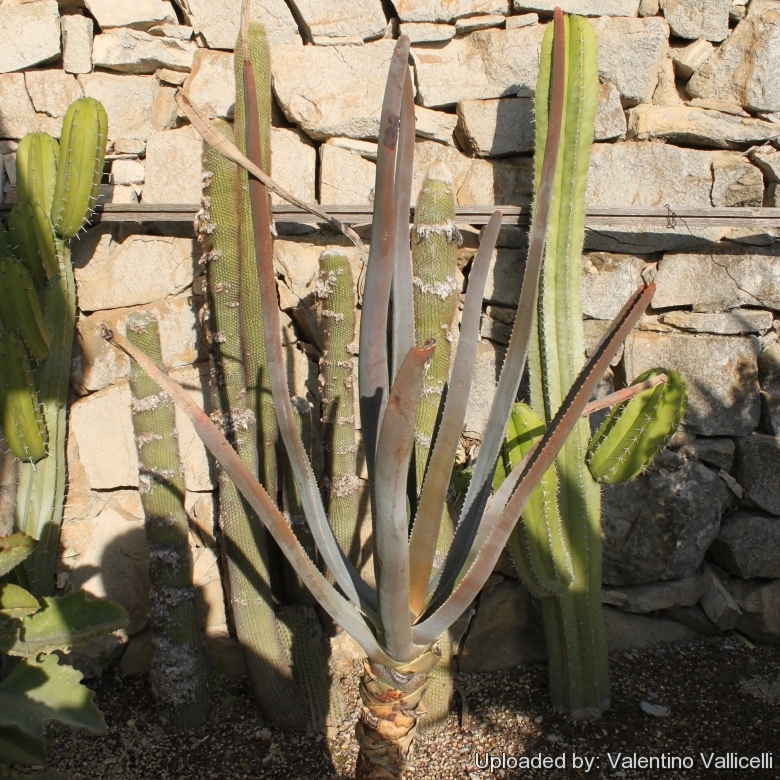
Aloe suzannae Photo by: Valentino Vallicelli
Origin and Habitat: Ambosary region and Itampolo in Southwestern Madagascar.
Habitat: It occurs in sandy shore or sometime on large rooks. Aloe suzannaeSN|709]]SN|709]] is very rare, it is said, there are only very few (maybe five) plant back in the nature!
Synonyms:
Common Names include:
ENGLISH: Tree aloe
CHINESE (中文): 索贊蘆薈
RUSSIAN (Русский): Алоэ Сюзанны
Description: It is a very slow growing tree aloe, that stay solitary or branches at the base when it become older. This is one of the larger Aloes, and is user-friendly (nothing sharp or dangerous).
Stem: The stem (trunk) will grow to more than 20 centimetres in diameter and it rises to more than 3 meters (may be up to 8 m tall).
Leaves: 80-100 cm long, with rounded tips and yellowish teeth arranged in a rosette (90-150 cm wide) at the top of the stem.
Flowers: This species produces spectacular more or less erect racemes (axillary spike) that looks like immense poles sometimes 1,5 to 6 m tall each raceme bears up to 1000 (or more) single white to yellow-crème flowers. The perianth is regular with segments nearly free. There are 6 stamens and a superior ovary consisting of 3 fused carpels. This flowers are supposed to be pollinated by bats and birds.
Blooming season: Late winter or early spring. Flowering is a rare event in this species with only maturing plants flowering (at least 20 to 30 years old), and that is infrequent (every 3-15 years).
Fruits: The fruits normally open into 3 pieces to release the seeds
 Aloe suzannae Photo by: Valentino Vallicelli
Aloe suzannae Photo by: Valentino Vallicelli Aloe suzannae Photo by: Valentino Vallicelli
Aloe suzannae Photo by: Valentino Vallicelli Aloe suzannae Photo by: Valentino Vallicelli
Aloe suzannae Photo by: Valentino Vallicelli Aloe suzannae Photo by: Valentino Vallicelli
Aloe suzannae Photo by: Valentino VallicelliCultivation and Propagation: Aloe suzannaeSN|709]]SN|709]] is a versatile plant and requiring little care.
Growth rate: It is of extremely slow growth, hence very rare in cultivation and highly prized by collectors, but it it possible to increase the speed of growth to some extent by providing adequate amount of water, warmth, and fertilizer during the active growing season, but it’s susceptible to rotting if too wet and do not like a lot of water when it is on rest.
Soil and pots: It can be grown in large containers. Always use a good quality, loamy sandy soil with plenty of drainage chips at the bottom of containers.
Watering: It tolerates weekly watering in the summer; once a month, or not at all in the colder months of winter. Can withstand long periods of drought, but they will thrive and flower more profusely if watered in the correct season. Incorrect watering, poor drainage or too much shade can lead to attack by pests and diseases.
Fertilization: Need a perfect fertilizer diet in summer. Use preferably a cacti and succulents fertilizer with high potassium content including all micro nutrients and trace elements or slow release fertilizer.
Wing tolerance: Only downside is from strong winds... best to plant in such a location where winds are not a big issue.
Exposure: It need a full sun exposure, but it can tolerate moderate shade, and a plant that has been growing in shade should be slowly hardened off before placing it in full sun as the plant will be severely scorched if moved too suddenly from shade into sun.
Hardiness: Tender. Avoid any frost. It grows much better outdoors in spring and summer. It prefers hot summers.
Gardening: This tree can be grown in large, rocky, well-drained soil in gardens in drier areas. In mild climates it can be cultivated outdoors for use in landscaping, preferably planting it in hot and dry rock gardens. It is very drought resistant but susceptible to frost. It will grow best in regions with a climate close to that of its native deserts – not too cold, and not too wet.
Propagation: Almost exclusively by seeds planted in autumn, in trays of coarse river sand. The plant on the trade are often from micropropagation as the seeds are very rare too.















